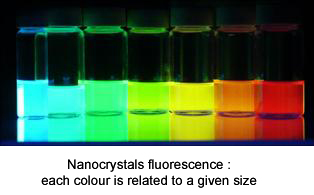Nanophysics, Nanostructures and Nanomaterials
Developing or organizing materials at the nano-scale allows to address new physics but also to design devices running on original principles. At the LPEM, several lines of research are developed in this direction from bottom-up or top-down approaches.
First, we develop the synthesis and characterization of colloidal semiconductor nanocrystals (“quantum dots”), whose optical properties are dominated by quantum confinement of charge carriers. Particle size (a few nm) controls for example the fluorescence wavelength. Many applications are possible, particularly in the field of biomedical and biological imaging. These applications require development of adequate surface chemistry, which is one of LPEM specificities. We have also designed new non-blinking nanoparticles, or nano-platelets whose thickness is controlled at the atomic level. New applications in the field of photovoltaics are currently under development.
 Metal nanoparticles (Au, Pt) are synthesized from similar synthetic schemes, and also for the first time superconducting nanoparticles (Pb). We can thus study the influence of quantum confinement on the electronic transport properties in assemblies and lattices of these nanoparticles. Significant results were obtained for the suppression of the Meissner effect in nanoparticles of Pb, but also on behavior such as "Coulomb glass" networks of Au nanocrystals. More generally, they are model systems to study superconductor-insulator and metal-insulator phase transitions.
Metal nanoparticles (Au, Pt) are synthesized from similar synthetic schemes, and also for the first time superconducting nanoparticles (Pb). We can thus study the influence of quantum confinement on the electronic transport properties in assemblies and lattices of these nanoparticles. Significant results were obtained for the suppression of the Meissner effect in nanoparticles of Pb, but also on behavior such as "Coulomb glass" networks of Au nanocrystals. More generally, they are model systems to study superconductor-insulator and metal-insulator phase transitions.
The top-down approach consists in nano-structuring thin films to control their shape at scales relevant to physics. For example, metal nanowires (Al, Ti) are made to study submicron heat transfer. By measuring the local temperature with a 100 nm spatial resolution using a near field probe developed in our laboratory, we highlight the specific roles of the wire and substrate topology on heat diffusion. Sub-wavelength optical systems are also studied, for example generation and study of surface plasmons or construction of nano-antennas to exalt the local field.
Finally, nanoscale systems are made from materials with strong electronic correlations, such as superconducting cuprates and manganites. Nanowires or nano-Josephson junctions of superconductors with high Tc are used to probe their intrinsic properties, but also to make devices. Measuring transport properties in manganite nanowires reveal intrinsic electronic inhomogeneities at submicron scales.
